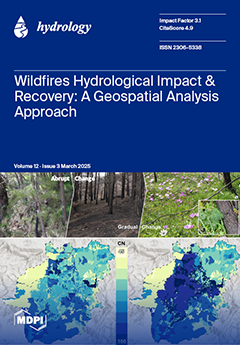Flash floods are highly destructive natural disasters, particularly in arid and semi-arid regions like Egypt, where data scarcity poses significant challenges for analysis. This study focuses on the Wadi Al-Barud basin in Egypt’s Central Eastern Desert (CED), where a severe flash flood occurred
[...] Read more.
Flash floods are highly destructive natural disasters, particularly in arid and semi-arid regions like Egypt, where data scarcity poses significant challenges for analysis. This study focuses on the Wadi Al-Barud basin in Egypt’s Central Eastern Desert (CED), where a severe flash flood occurred on 26–27 October 2016. This flash flood event, characterized by moderate rainfall (16.4 mm/day) and a total volume of 8.85 × 10
6 m
3, caused minor infrastructure damage, with 78.4% of the rainfall occurring within 6 h. A significant portion of floodwaters was stored in dam reservoirs, reducing downstream impacts. Multi-source data, including Landsat 8 OLI imagery, ALOS-PALSAR radar data, Global Precipitation Measurements—Integrated Multi-satellite Retrievals for Final Run (GPM-FR) precipitation data, geologic maps, field measurements, and Triangulated Irregular Networks (TINs), were integrated to analyze the flash flood event. The Soil Conservation Service Curve Number (SCS-CN) method integrated with several hydrologic models, including the Hydrologic Modelling System (HEC-HMS), Soil and Water Assessment Tool (SWAT), and European Hydrological System Model (MIKE-SHE), was applied to evaluate flood forecasting, watershed management, and runoff estimation, with results cross-validated using TIN-derived DEMs, field measurements, and Landsat 8 imagery. The SCS-CN method proved effective, with percentage differences of 5.4% and 11.7% for reservoirs 1 and 3, respectively. High-resolution GPM-FR rainfall data and ALOS-derived soil texture mapping were particularly valuable for flash flood analysis in data-scarce regions. The study concluded that the existing protection plan is sufficient for 25- and 50-year return periods but inadequate for 100-year events, especially under climate change. Recommendations include constructing additional reservoirs (0.25 × 10
6 m
3 and 1 × 10
6 m
3) along Wadi Kahlah and Al-Barud Delta, reinforcing the Safaga–Qena highway, and building protective barriers to divert floodwaters. The methodology is applicable to similar flash flood events globally, and advancements in geomatics and datasets will enhance future flood prediction and management.
Full article





